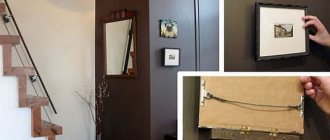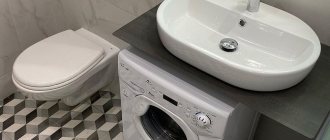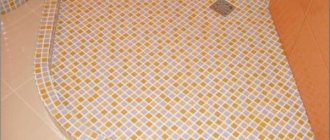We all know that the kitchen is a workspace and a trash can is necessary, but we don't want to have it in sight or trip over it every few minutes. This article provides you with a number of practical solutions that will help you manage your kitchen waste conveniently and keep it out of sight.
Some of the ideas we have collected involve simply changing the trash can, others may require the help of specialists, and others you can easily implement with your own hands. Maybe you already have experience? We will be glad if you share it in the comments!
In the meantime, let's look at the 5 best ways to label your kitchen trash can:
Place under the sink (traditional solution)
This option is optimal for a kitchen of any size. And if there is also a cabinet under the sink, then this may be the easiest way to keep waste out of sight. BUT! What do we do with such a bucket during the cooking process? We have to either take it out and put it under our feet, or constantly bend down under the sink to carefully throw out the garbage and not miss.
Therefore, if while cooking you take out a bucket and place it near you, then we advise you to purchase a trash can with a pedal: on the one hand, the garbage is hidden from your eyes, and on the other, you do not need to bend down to lift the lid.
An even more convenient option may be a bucket without a pedal, but with a functional lid that comes off with light pressure. The only drawback of such a trash can is the need to monitor the cleanliness of this very lid.
So, we’ve figured out the simplest and most obvious way to place a trash can. All subsequent solutions do not require you to remove the trash can from its designated place in the kitchen.
Tricky trick with an old trash can
What about a little handmade? An interesting option would be to paint an existing trash can and stencil designs on it. The most ordinary trash container can become a real work of art.
A regular trash can with a stencil design on it
Gorgeous Rustic Garbage Bin
Galvanized trash can, striped painted
Attach to cabinet door
It's really very convenient. In addition, today you can attach a trash can to a cabinet door either independently, using a simple metal frame, or with the help of special installations, which are sold in most stores and include interesting pull-out options for corner kitchens and much more.
By the way, have you ever thought about separating your waste? Today, many yards have special containers for plastic bottles, and more and more people are trying to do their part to save the environment. You may also find it very convenient to separate perishable waste from all other waste. However, in a case like this, where you want to have more than one bucket, you'll probably be happier using a drawer rather than an over-the-door installation. Let's look at this option.
Advantages and disadvantages
Built-in trash cans have both advantages and disadvantages. First, let's look at the main advantages of retractable models, namely:
- the lid opens automatically;
- hygiene and ergonomics;
- functionality;
- ease of use;
- if desired, placement of 2-3 cells, which allows for waste sorting;
- quick and easy installation;
- in the event of a breakdown, the retractable mechanism can be quickly repaired independently or replaced with a new one;
- There is no need to wash your hands after each time you throw out trash, since you don't touch the handle.
Organize your drawer
What is the main advantage of a drawer over shelves when it comes to the lower part of the kitchen? It is obvious and undeniable: it is much more convenient to put in it and even more pleasant to take out various objects. From above you can immediately see what is where, and there is no need to move things around to find what you need. Even if you use one trash can, and there will be a lot of free space in the drawer, there will definitely be something to put in it, for example, detergents and cleaning products, spare sponges
And if you also place a pull-out board right above the drawer with the trash can, as shown in the photo below, then your comfort while cooking will increase significantly!
What will you need for work?
In order to make your own garbage collection tank and build it into the cabinet door, you will need the following:
- a sheet of thickened plywood or any other suitable materials, for example, cutting boards;
- saw;
- wood glue or all-purpose glue;
- metal fastenings - brackets or corners, depending on the specific location of the tank;
- hardware;
- sanding machine or drill attachment, coarse sandpaper.
For marking you will need a square, a long ruler and a pencil. Measurements of the inner cabinet door can be taken either with a ruler or tape measure. For decoration you will need paint and a brush. Since the trash can will be washed regularly, you need to choose a water-resistant paint, for example, oil-based.
Russian schoolchildren told who they consider their heroes
In six months, Russians will receive a device for home testing for coronavirus
Iron patience: baby waits for dad to look at her (video)
Mount into countertop
This is perhaps the most creative kitchen waste solution on our list, and perhaps one of the most convenient. We bring to your attention an interesting device that is mounted directly into the countertop.
It consists of a tank, which is placed inside a deep box and can be removed from it if necessary, and a simple flat lid. Agree: it looks neat and quite presentable. However, we note that only a few companies currently present such products on the market, for example, Ikea, Blum and Hettich.
Let us draw your attention to one more interesting detail. Some of these trash cans, like this model from Poh Joo, have an outlet with a plug that can be connected to a drain pipe. This makes it very easy to clean the bucket after disposing of the waste.
Place it near the table
And finally, here’s what our last option looks like, suggesting that it’s still more convenient for you to keep the trash can at hand, rather than constantly opening and closing some drawers or doors.
True, this solution is best suited for kitchens with an “island”, or for kitchens where a free corner or niche for a trash can was provided in advance. It’s simply wonderful that today manufacturers make containers in a variety of shapes, sizes and colors, so you and I can choose a stylish option that won’t take up much space.
Garbage storage system in the kitchen
Perhaps the biggest problem in organizing a kitchen space is where to put the trash can. It is often placed under the sink, but this approach cannot be called hygienic. In this area, even with the most insulated pipes, increased humidity is observed.
Therefore, the garbage begins to rot, spreading bacteria into the air. This can only be avoided if you take out the trash can before each time you turn on the water or take the trouble to buy a sealed tank that does not allow moisture to pass through.
However, if you have such a bucket, you don’t have to hide it. You can place the garbage container in any corner of the kitchen where it will not disturb you. Sometimes headsets have a special compartment for a trash can - this is convenient and practical. However, we recommend not placing it directly near the stove - when heated, the garbage begins to emit an unpleasant aroma.
In any case, no matter what location of the bin you choose, remember that the garbage must be taken out every day. Even if it seems that “there is still room there” and “it’s almost empty!”
Storage system under the sink in the kitchen: hygiene issues
If you decide that there is no place for a trash can under the sink, you free up additional storage space. It should not be used to store food or dishes - high humidity will not do them any good. But the cabinet under the sink is ideal as a compartment for kitchen hygiene items. There are a few general rules here:
- If you want to install shelves under the sink, make sure they can be removed. Even with the highest quality pipes, the possibility of leakage cannot be ruled out. Therefore, you should be able to quickly remove everything that is stored under the sink.
- If you leave cleaning supplies there, make sure they are sealed tightly. Otherwise, condensation or random drops of water may ruin the product.
- Always throw away products that have expired - they may be unsafe to use in the kitchen.
- Maintain order: do not store empty bottles.
- If the product is sold in a bag, it is better to pour it or pour it into a jar - this is much more convenient and ergonomic.
It is very important to ensure that your under-sink storage shelves are moisture-resistant. Use special adhesive tape to laminate the edges. It is inexpensive, but will prevent deformation and swelling. In addition, you should not buy shelves or dividers made of chipboard - for all its advantages, the material deteriorates very quickly under the influence of moisture.
Interior cabinet doors also need protection. Cover them with self-adhesive film or order a set with plastic doors in an aluminum profile. This will prevent its damage and extend its lifespan for a long time. We recommend placing plastic or aluminum trays at the bottom of the cabinet - they will not only retain water in the event of a leak, but will also help organize space for storing detergents.
If you have a small kitchen, we recommend making a pull-out shelf directly under the sink - it will be suitable for storing sponges and scrapers. Usually this space is not used, so you can consider that you are giving yourself extra square centimeters.
Modern idea! Some furniture companies now produce sinks with built-in dispensers. It's comfortable and stylish. True, such a wash will not be cheap.
As for sponges and scrapers, the issue of storing them is one of the most difficult. Never put sponges in sinks! This causes them to deteriorate and begin to emit an unpleasant aroma. Moreover, this approach is simply unhygienic. Buy a special stand. It can be either hanging or in the form of a regular soap dish, perhaps a little wider. Here, focus on your convenience and aesthetic preferences.
Textiles, such as towels and potholders, also need an organized storage system. Never hang them near the hob! Even natural fabrics deteriorate from constant exposure to heat. Synthetics can simply melt. You can select a special box for storing kitchen textiles, but a system of hanging hooks (rails) is much more effective. This way you will always have the necessary towel or oven mitt at hand.
Lifehack! Instead of countless, not very aesthetic rags for wiping surfaces, purchase a roll of paper towels. It's much more hygienic and looks neater. In addition, you will save time on washing.
Kinds
Almost all models of built-in trash cans consist of three parts:
- external body (frame, base);
- removable internal containers;
- covers.
The body and lid can be side-mounted to the bottom, cabinet wall or facade. Differences in fastenings determine ease of use.
- There are automatic models that extend when the facade is opened. In this case, the lid remains in place. When moving back, the bucket snaps into place and closes. Moreover, you can store things on such a lid. This is the most convenient and hygienic option, since you don’t need to touch the bucket and lid with your hands, get dirty and spend effort on it.
- There are also semi-automatic models, the body of which moves (on wheels or using guides). But the lids of the containers will have to be opened manually. In the simplest version, you will even have to pull out the bucket manually.
Built-in trash cans can be either plastic or metal.
- Plastic. Such products are light in weight and easy to handle. Plastic washes well, but contact with caustic chemicals is undesirable. In addition, if there is excessive load, impact or careless handling, such a bucket may be damaged. Plastic models can be colored, and other material options provide variety in design.
- Metal. Since there are different types of waste, stainless steel is most often used. Such a bucket will be strong and durable. Matte metal surfaces are more practical, dirt is less visible on them, and they are easier to care for than shiny ones. Stainless steel accessories are usually chosen to fill kitchens in one of the modern styles. Metal of dubious quality is quite capricious - it can develop corrosion due to contact with water, liquid and semi-liquid waste.
Simple models of waste collection buckets are often made entirely of one material. But metal waste systems are almost always diluted with plastic parts. There are a couple of reasons for this.
- Practicality. Internal plastic containers significantly reduce the weight of the structure and cleaning. In addition, plastic can protect against strong slams of the metal lid on the body.
- Combined models are much cheaper than metal ones. And so that the appearance does not suffer, all external surfaces can be made to look like stainless steel.
But you should pay closer attention to the fastenings and the withdrawable mechanism. There should be as little plastic as possible here - fragile parts often break and require additional costs for repairs. In addition, poor fastenings can cause irreparable damage to kitchen furniture.











